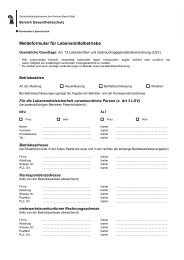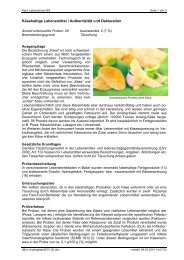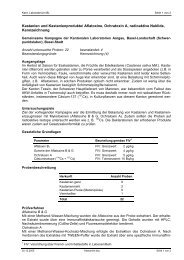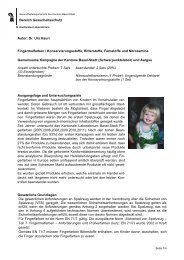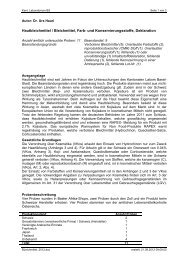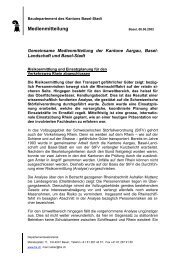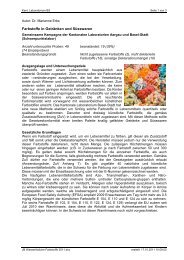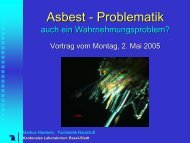Inks for tattoos and PMU (permanent make-up) / Organic pigments ...
Inks for tattoos and PMU (permanent make-up) / Organic pigments ...
Inks for tattoos and PMU (permanent make-up) / Organic pigments ...
Create successful ePaper yourself
Turn your PDF publications into a flip-book with our unique Google optimized e-Paper software.
State Laboratory of the Canton Basel City Page 1 of 10<br />
Author:<br />
Dr. Urs Hauri<br />
<strong>Inks</strong> <strong>for</strong> <strong>tattoos</strong> <strong>and</strong> <strong>PMU</strong> (<strong>permanent</strong> <strong>make</strong>-<strong>up</strong>) / <strong>Organic</strong> <strong>pigments</strong>, preservatives<br />
<strong>and</strong> impurities such as primary aromatic amines <strong>and</strong> nitrosamines<br />
Joint campaign by the Swiss Association of Cantonal Chemists (Verb<strong>and</strong> der<br />
Kantonschemiker der Schweiz – VKCS) with financial s<strong>up</strong>port from the FOPH (Swiss<br />
Federal Office of Public Health), laboratory in charge : Basel City<br />
Number of samples tested:<br />
Total: 190<br />
Tattooing inks: 167<br />
<strong>PMU</strong> dyes: 23<br />
Total samples objected to<br />
96 (51%)<br />
88 (53%)<br />
8 (35%)<br />
Banned from use<br />
63 (33%)<br />
61 (37%)<br />
2 (9%)<br />
Reasons <strong>for</strong> objection*:<br />
Banned due to declaration of prohibited substances<br />
Banned due to analysis results<br />
Objection due to high nitrosamine content<br />
Objection due to undeclared ingredients<br />
Objection due to declaration<br />
* More than one reason <strong>for</strong> objection is possible per sample.<br />
Total<br />
21<br />
59<br />
17<br />
98<br />
83<br />
Tattoo<br />
21<br />
57<br />
15<br />
90<br />
79<br />
<strong>PMU</strong><br />
-<br />
2<br />
2<br />
8<br />
4<br />
Summary<br />
• The national campaign to investigate the inks in <strong>tattoos</strong> <strong>and</strong> <strong>permanent</strong> <strong>make</strong>-<strong>up</strong> showed a<br />
pleasing <strong>and</strong> significant reduction in the number of objections, down by 25% compared with<br />
the 2009 campaign. The reason <strong>for</strong> this must surely be that many manufacturers <strong>and</strong><br />
studios have taken action following the poor results. Un<strong>for</strong>tunately, this good news story is<br />
tarnished by the fact that objections were still raised concerning one in two samples, which<br />
is unacceptable from the point of view of consumer protection. While the situation regarding<br />
the use of azo dyes <strong>and</strong> the nitrosamine content as well as the use of banned preservatives<br />
has improved greatly in the last two years, banned colourants are still being used far too<br />
often in tattooing studios. As our investigations showed, un<strong>for</strong>tunately studios cannot always<br />
rely on the manufacturers. On the other h<strong>and</strong>, many studios pay too little attention to<br />
carrying out their own checks <strong>and</strong> use products which are obviously not legal, either<br />
because the declared ingredients are not permitted or because exact details about <strong>pigments</strong><br />
or the preservatives that have been used are missing.<br />
• Furthermore, differences or omissions in legislation do not <strong>make</strong> it easy <strong>for</strong> manufacturers to<br />
produce products that comply with regulations. A further complication is that the<br />
manufacturers are unable to find any s<strong>up</strong>pliers of <strong>pigments</strong> of "tattooing quality", with the<br />
result that they use contaminated <strong>and</strong> poorly defined <strong>pigments</strong> which are often mixed with<br />
other unknown additives. Often the manufacturer is not really familiar with his product, <strong>and</strong><br />
so cannot provide a complete declaration of the ingredients <strong>and</strong> may well run the risk of<br />
contaminants such as nitrosamines being <strong>for</strong>med. In some cases, however, the<br />
manufacturer <strong>make</strong>s a conscious decision not to declare the ingredients in order to protect<br />
his commercial secrets. At best, the ingredients are then listed under catch-all terms such as<br />
"Preservatives" or "Detergents". In the interests of consumer protection, this should be a<br />
clear indication to the studios to steer clear of these products.<br />
• Many consumers are not aware that the ingredients of tattooing <strong>and</strong> <strong>PMU</strong> dyes are not<br />
subject to any kind of testing or licensing by national health authorities. Whereas cosmetics<br />
manufacturers have to restrict themselves when choosing colourants to a list of permitted,<br />
toxicologically assessed substances (a positive list), this is not the case <strong>for</strong> the producers of<br />
tattooing inks. The <strong>pigments</strong> that are used are not tested toxicologically <strong>for</strong> use in tattooing<br />
inks. Furthermore, some <strong>pigments</strong> can be broken down into toxic substances by exposure to<br />
UV light or if <strong>tattoos</strong> are removed by laser. These aspects are also not (yet) taken into<br />
account in legislation.<br />
• In view of these unsatisfactory results, it is obvious that tattooing inks <strong>and</strong> <strong>PMU</strong> dyes must<br />
continue to be tested regularly over the coming years.<br />
Drafted: 18.10.2011
State Laboratory of the Canton Basel City Page 2 of 10<br />
• Initial situation<br />
Tattoos are fashionable <strong>and</strong> have been so <strong>for</strong> years. According to a survey [1] by the University<br />
of Leipzig, every fourth person between the ages of 15 <strong>and</strong> 35 in Germany in 2009 had at least<br />
one tattoo. There is no comparable data about the situation in Switzerl<strong>and</strong>.<br />
Permanent <strong>make</strong>-<strong>up</strong> is a special <strong>for</strong>m of tattooing which is mainly used to highlight the<br />
eyebrows or lips, or to conceal scarring after operations. In view of how widespread tattooing is,<br />
it is surprising that the dyes used <strong>for</strong> it were not legally s<strong>up</strong>ervised until recently, <strong>and</strong> that to this<br />
day they are still not regulated in many countries in Europe.<br />
In Switzerl<strong>and</strong>, tattooing <strong>and</strong> the inks used <strong>for</strong> it <strong>and</strong> <strong>PMU</strong> were made subject to the Swiss Food<br />
Act (Lebensmittelgesetz – LMG) in 2006 <strong>and</strong> specifications were defined <strong>for</strong> the microbiological<br />
<strong>and</strong> chemical quality of the products that are used, <strong>and</strong> <strong>for</strong> how they should be declared. The<br />
Swiss requirements are based on a European Council Resolution [2] of 2003, which was<br />
modified in 2008 (European Council Resolution 2008) [3]. However, the European Union has no<br />
st<strong>and</strong>ardised regulatory system <strong>and</strong> national regulations vary greatly (e.g. Germany,<br />
Netherl<strong>and</strong>s) or are non-existent (e.g. UK, Sweden).<br />
The inadequate or inconsistent regulations have a negative effect on the st<strong>and</strong>ard of quality<br />
control regarding the dyes that are used, as was confirmed in 2009 by a Swiss market survey.<br />
Bans had to be imposed on the use of 54% of the dyes, most of which were collected from<br />
tattooing studios, <strong>and</strong> on 11% of <strong>PMU</strong> dyes. Only one in five products (21%) was legally<br />
compliant. On the basis of the results of this study, which were reported on in detail in the<br />
Bulletin [4, 5] produced by the FOPH, the general public were in<strong>for</strong>med <strong>and</strong> the banned<br />
products were listed on the FOPH website. In this way the tattooing studios were able to find out<br />
which products they would no longer be allowed to use in future. Subsequently, guidelines <strong>for</strong><br />
assessing tattooing inks were published by both the FOPH <strong>and</strong> the State Laboratory of the<br />
Canton Basel City (FOPH, KLBS).<br />
Purposes of the investigation<br />
The purpose of repeating the national campaign involving the FOPH <strong>and</strong> all the cantons was to<br />
find out whether the studios' self-regulation of tattooing <strong>and</strong> <strong>PMU</strong> dyes had improved <strong>and</strong><br />
whether the proportion of non-compliant products had fallen noticeably.<br />
Legal principles<br />
The specifications <strong>for</strong> tattooing <strong>and</strong> <strong>PMU</strong> dyes are defined in the Swiss Human Contact<br />
Ordinance (Verordnung über Gegenstände für den Humankontakt – HKV). Most of the chemical<br />
specifications are based on the regulations <strong>for</strong> cosmetics (CMR substances, colourants,<br />
preservatives) or <strong>for</strong> consumer goods (aromatic amines).<br />
Parameters<br />
Aromatic amines <strong>and</strong> banned azo dyes<br />
Colourants<br />
Fragrances<br />
CMR substances* (nitrosamines, phthalates, etc.)<br />
Preservatives<br />
Requirements <strong>for</strong> the declaration<br />
Assessment<br />
HKV Art. 5, paragraph 3a<br />
HKV Art. 5, paragraph 3b <strong>and</strong> 3c<br />
HKV Art. 5, paragraph 3d<br />
HKV Art. 5, paragraph 3e<br />
HKV Art. 5, paragraph 4<br />
HKV Art. 8, 1a-f<br />
*CMR substances: Substances which are categorised as carcinogenic (C), mutagenic (M) or toxic to reproduction (R)<br />
There is zero tolerance of substances with CMR properties <strong>and</strong> of banned dyes <strong>and</strong><br />
preservatives. However, since very low concentrations of preservatives can be introduced into<br />
the products by the raw materials <strong>and</strong> some CMR substances are technically virtually<br />
impossible to avoid, traces of these substances at a safe level were not objected to, in the<br />
interests of commensurability.<br />
Drafted: 18.10.2011
State Laboratory of the Canton Basel City Page 3 of 10<br />
Description of the samples<br />
A total of 190 samples were collected from 72 tattooing <strong>and</strong> <strong>PMU</strong> studios <strong>and</strong> from 3 importers<br />
in all the Swiss cantons <strong>and</strong> in the Principality of Liechtenstein. The samples came from 34<br />
tattooing ink manufacturers <strong>and</strong> 9 producers of <strong>PMU</strong> dyes.<br />
Origin<br />
No. of Tattooing <strong>PMU</strong><br />
samples inks dyes<br />
Germany 62 48 14<br />
USA 58 56 2<br />
Australia 17 17 0<br />
Switzerl<strong>and</strong>* 9 7 2<br />
Italy 9 9 0<br />
Japan 9 9 0<br />
Brazil 9 9 0<br />
Engl<strong>and</strong> 6 6 0<br />
Unknown 4 4 0<br />
Austria 3 0 3<br />
Holl<strong>and</strong> 2 0 2<br />
France 1 1 0<br />
China 1 1 0<br />
Total 190 167 23<br />
* The Swiss tattooing inks that were investigated have<br />
not been available from retailers <strong>for</strong> a considerable<br />
time now.<br />
Colour<br />
No. of<br />
samples<br />
Red 31<br />
Black 24<br />
Green 24<br />
Yellow 22<br />
Violet/purple/lilac 19<br />
Brown 19<br />
Blue 19<br />
Orange 14<br />
Pink/rose/magenta 12<br />
Grey 4<br />
White 2<br />
Total 190<br />
Test procedures<br />
Preservatives <strong>and</strong> other UV-active substances<br />
In analysing the tattooing <strong>and</strong> <strong>PMU</strong> inks, three methods from the field of cosmetics were used to<br />
identify the preservatives.<br />
Well over 50 UV-active preservatives were screened <strong>for</strong>, following extraction using acidic<br />
methanol, by using a UHPLC/DAD multi method. This method was also used to screen <strong>for</strong><br />
dibutyl, benzylbutyl <strong>and</strong> diethylhexyl phthalates, UV-active fragrances <strong>and</strong> other ingredients<br />
(tensides, impurities, etc.).<br />
The polar preservatives methylisothiazolinone, methylchloroisothiazolinone <strong>and</strong><br />
benzisothiazolinone were identified <strong>and</strong> quantified using HPLC/DAD, after being extracted using<br />
aqueous <strong>and</strong> aqueous-methanoic <strong>for</strong>mic acid.<br />
Formaldehyde was also detected by HPLC/DAD following derivatisation with 2,4-<br />
dinitrophenylhydrazine. The same method was used to screen <strong>for</strong> glutardialdehyde <strong>and</strong> glyoxal.<br />
Glyoxal was measured using UHPLC/DAD after converting it with o-phenylenediamine to<br />
quinoxaline.<br />
<strong>Organic</strong> <strong>pigments</strong><br />
The main method used <strong>for</strong> qualitative analysis of organic <strong>pigments</strong> was MALDI-TOF mass<br />
spectrometry. This allowed most of the <strong>pigments</strong> that were used to be analysed directly from the<br />
dyes themselves, without adding a matrix. Wherever possible, results were verified using the<br />
UHPLC/DAD multi method, with the <strong>pigments</strong> being extracted from the samples using N,N<br />
dimethyl<strong>for</strong>mamide or dichloromethane. Along with poor solubility, the biggest problem in the<br />
analysis lay in obtaining reference substances.<br />
Carcinogenic aromatic amines as evidence of banned azo <strong>pigments</strong><br />
Evidence of banned azo dyes was obtained by using a st<strong>and</strong>ard method used on textiles. [6].<br />
The reduced extracts were analysed directly with no purification using LC/MS/MS (as described<br />
in [7]).<br />
Carcinogenic N nitrosamines<br />
An LC/MS/MS method was used to analyse ten carcinogenic N nitrosamines. The substances<br />
were extracted from the samples using water, <strong>and</strong> in the case of quantifying nitrosodibutylamine<br />
using methanol/water. To quantify N-nitrosodiethanolamine, positive samples were analysed in<br />
a second LC/MS/MS process using column switching, in order to keep precursors away from<br />
Drafted: 18.10.2011
State Laboratory of the Canton of Basel-Stadt Page 4 of 10<br />
the actual separation column <strong>and</strong> achieve additional selectivity. N-nitrosomorpholine <strong>and</strong> N-<br />
nitrosodibutylamine were also measured using a further LC/MS/MS process.<br />
Results <strong>and</strong> measures taken<br />
Summary<br />
Objections were raised in 96 (51%) of the 190 tattooing <strong>and</strong> <strong>PMU</strong> dyes that were investigated.<br />
Compared with the first national campaign in 2009, this is a slight improvement, especially with<br />
regard to tattooing inks (Table 1). Samples however were not examined microbiologically in<br />
2011. Even though considerably more tattooing inks than <strong>PMU</strong> dyes were collected this year,<br />
the overall proportion giving grounds <strong>for</strong> complaint fell from 76 to 51%. The proportion of<br />
products banned from use fell from 41 to 33%. In general, the same improving trend could be<br />
observed in both tattooing inks <strong>and</strong> <strong>PMU</strong> dyes, although the small number of samples of <strong>PMU</strong><br />
dyes meant that the survey was not representative.<br />
Table 1 – Comparison between the numbers of objections in 2011 <strong>and</strong> in 2009<br />
Number of samples tested: Total samples objected to Banned from use<br />
2011 2009 2011 2009 2011 2009<br />
Total: 190 152 51% 76% 33% 41%<br />
Tattooing inks: 167 105 53% 87% 37% 54%<br />
<strong>PMU</strong> dyes: 23 47 35% 60% 9% 11%<br />
When it comes to the reasons <strong>for</strong> imposing a ban on use, it is noticeable that the situation<br />
regarding the main ingredients, the <strong>pigments</strong>, has not improved (Table 2). On the other h<strong>and</strong>,<br />
thanks to multiple inspections of the manufacturers, hardly any products containing banned azo<br />
dyes were found this time. Far fewer banned preservatives were found, too, <strong>and</strong> there was also<br />
a clear improvement regarding nitrosamines. While many samples did still contain nitrosamines<br />
(12% compared with 15% in 2009), this year we observed no serious contamination of more<br />
than 150 µg/kg. The number of cases where the limits <strong>for</strong> permitted preservatives had been<br />
exceeded has increased slightly.<br />
Table 2 – Comparison between the numbers of bans on use in 2011 <strong>and</strong> in 2009<br />
Reason <strong>for</strong> the ban on use 2011 2009<br />
Banned colourants 29% 23%<br />
Banned preservatives*** 8% 14%<br />
Exceeding of limits <strong>for</strong> preservatives 3% 0.7%<br />
Aromatic amines / azo dyes 0.5% 6%<br />
N-nitrosamines** 0% 7%<br />
Microbiology * 3%<br />
* No analysis carried out; ** Content > 150 µg/kg; *** Content > 50 mg/kg<br />
Pigments<br />
<strong>Organic</strong> <strong>pigments</strong><br />
Even though Swiss legislation on colourants is in line with the European Council resolution from<br />
2003 <strong>and</strong> the German Tattooing <strong>Inks</strong> Ordinance (Tätowiermittel-Verordnung), more than a<br />
quarter of the samples (50 samples, 56 reasons <strong>for</strong> objection; Table 3) had to be banned from<br />
use because they contained prohibited organic <strong>pigments</strong>. In one sample we found the explicitly<br />
banned colourants C.I. 45160 <strong>and</strong> C.I. 45170, while the other samples contained colourants<br />
which are not permitted <strong>for</strong> all purposes in cosmetics, <strong>and</strong> there<strong>for</strong>e are not permitted in<br />
tattooing <strong>and</strong> <strong>PMU</strong> dyes (C.I. 11680, C.I. 11710, C.I. 12370, C.I. 21108, C.I. 51319, C.I. 73900,<br />
C.I. 73915 <strong>and</strong> C.I. 74260).<br />
Drafted: 18.10.2011
State Laboratory of the Canton of Basel-Stadt Page 5 of 10<br />
Table 3 – <strong>Organic</strong> <strong>pigments</strong> – Reasons <strong>for</strong> objection<br />
Reason <strong>for</strong> objection<br />
No. of<br />
samples<br />
Frequency<br />
Missing declaration (of which failures to declare colourants) 23 [11] 12 [6%]<br />
Declared banned colourants 28 15%<br />
Detection of banned, undeclared colourants (analysis) 34 18%<br />
Detection of permitted, undeclared colourants (analysis) 11 6%<br />
Samples objected to in connection with the colourants 61 32%<br />
Samples objected to because of undeclared permitted colourants 10 5%<br />
Samples banned from use because of prohibited colourants 50 26%<br />
While the white, grey <strong>and</strong> black colours presented no problem with regard to the <strong>pigments</strong> that<br />
were used, a third of the coloured products contained banned <strong>pigments</strong>. In over half of the<br />
cases, this was easy to detect by looking at the declaration: either the banned <strong>pigments</strong> were<br />
declared (22 samples, 28 <strong>pigments</strong>), or no colourants at all were declared (10 samples),<br />
meaning that the products were not fit <strong>for</strong> sale in any case. This clearly indicates that a<br />
considerable number of the studios were not carrying out their own controls properly.<br />
The situation among the manufacturers also gives cause <strong>for</strong> concern. Not only did some old<br />
products, which have apparently been in use <strong>for</strong> years, contain banned <strong>pigments</strong>, this was even<br />
the case with some new products. In some cases, it is claimed on the Internet that the products<br />
meet European requirements, <strong>and</strong> this is confirmed by certificates of analysis <strong>for</strong> impurities.<br />
However, it would have only taken a careful look at the declaration to see that these products<br />
certainly do not comply with the European Council Resolution!<br />
Our analysis revealed 34 banned <strong>pigments</strong> used in 30 samples. The fact that banned <strong>pigments</strong><br />
are either not declared, or incorrectly declared, in so many cases suggests that some products<br />
were being deliberately labelled incorrectly in order to be able to offer consumers an apparently<br />
legal product.<br />
For example, in three cases of green inks, the pigment C.I. 74265 was declared, but the<br />
samples contained the banned pigment C.I. 74260. Similarly, <strong>for</strong> one ink a yellow <strong>and</strong> a blue<br />
pigment were declared, but again C.I. 74260 was responsible <strong>for</strong> the colour. The declaration on<br />
a violet ink was obviously incorrect: according to the declaration, the ink contained the white<br />
pigment titanium dioxide <strong>and</strong> the blue pigment C.I. 74160 – together these would <strong>make</strong> light<br />
blue. However, the violet colour came from the banned pigment C.I. 51319. Incorrect<br />
declarations were also found on other purple inks. Two of them contained C.I. 51319 even<br />
though the <strong>pigments</strong> declared were red <strong>and</strong> blue. In another sample containing C.I. 51319, a<br />
mixture of a white <strong>and</strong> a red pigment containing manganese violet (C.I. 77742) was declared.<br />
Declaring a red <strong>and</strong> a black pigment was s<strong>up</strong>posed to conceal the presence of C.I. 73915.<br />
One German manufacturer whose product range otherwise contained legal <strong>pigments</strong> was<br />
unlucky. Our analysis of samples containing the pigment Red 282 tested positive <strong>for</strong> C.I. 73915,<br />
which, as mentioned above, is banned. According to the safety data sheets, the pigment Red<br />
282 is not a single substance but a mixture of quinacridone <strong>pigments</strong>. The main ingredient in<br />
this mixture is in fact the banned pigment C.I. 73915, which is sold as an unblended substance<br />
called Pigment Red 122. This was not known to either the tattoo manufacturer or ourselves. The<br />
manufacturer was able to show us an older safety data sheet on which this in<strong>for</strong>mation did not<br />
yet appear.<br />
We regard the regulation of colourants using negative lists to be unsatisfactory, because the<br />
indirect consequence of this is that all colourants whose use is not regulated by the Cosmetics<br />
Ordinance, <strong>and</strong> which do not release carcinogenic aromatic amines following reductive splitting<br />
in accordance with EN 14362, are permitted <strong>for</strong> use in tattooing <strong>and</strong> <strong>PMU</strong> dyes. This means that<br />
colourants are permitted that have not been subjected to toxicology testing <strong>for</strong> either cosmetics<br />
or tattooing use, with the result that organic <strong>pigments</strong> are being used in 56% of the dyes (Table<br />
4). This is a definite increase compared with 2009.<br />
Drafted: 18.10.2011
State Laboratory of the Canton of Basel-Stadt Page 6 of 10<br />
Table 4: <strong>Organic</strong> <strong>pigments</strong> in tattooing <strong>and</strong> <strong>PMU</strong> dyes: frequency of use <strong>and</strong> legal status<br />
Proportion of samples containing<br />
colourants*:<br />
Legal basis<br />
Permitted 24% Cosmetics Ordinance, Appendix 2, Column 1<br />
Banned 32%<br />
Cosmetics Ordinance, Appendix 2, Columns 2-4 (31%); Human<br />
Contact Ordinance, Appendix 2 (1%);<br />
Unregulated 56%<br />
Not listed in either the Cosmetics Ordinance or the Human<br />
Contact Ordinance<br />
* Totals do not add <strong>up</strong> to 100% because some dyes may contain colourants in more than one category.<br />
Pigment<br />
Colour<br />
Frequency<br />
in samples Legal status Comments<br />
C.I. 74160 Blue 18% Permitted<br />
C.I. 74260 Green 8% Banned<br />
C.I. 12475 Red 7% Not regulated<br />
C.I. 11741 Yellow 7% Not regulated May release o-anisidine*<br />
C.I. 11767 Yellow 7% Not regulated<br />
C.I. 51319 Violet 7% Banned<br />
C.I. 73915 Magenta 7% Banned 5 colourants declared as Pigment Red 282<br />
C.I. 561170 Orange 6% Not regulated<br />
C.I. 56110 Red 5% Not regulated<br />
C.I. 12477 Red 4% Not regulated<br />
C.I. 21110 Orange 4% Not regulated May release 3,3'-dichlorobenzidine<br />
C.I. 74265 Green 4% Not regulated<br />
C.I. 11680 Yellow 3% Banned<br />
C.I. 56300 Yellow 3% Not regulated<br />
C.I. 12490 Red 3% Permitted<br />
C.I. 11710 Yellow 2.1% Banned<br />
C.I. 11740 Yellow 2.1% Not regulated May release o-anisidine*<br />
C.I. 12370 Red 2.1% Banned May release o-toluidine<br />
C.I. 12085 Red 1.6% Permitted<br />
C.I. 13980 Yellow 1.6% Not regulated<br />
C.I. 12510 Brown 1.1% Not regulated<br />
C.I. 51345 Violet 1.1% Not regulated<br />
C.I. 73907 Magenta 1.1% Not regulated<br />
C.I. 12485 Red 0.5% Not regulated<br />
C.I. 15580 Red 0.5% Permitted<br />
C.I. 15850 Red 0.5% Permitted<br />
C.I. 21095 Yellow 0.5% Not regulated May release 3,3'-dichlorobenzidine <strong>and</strong> o-toluidine*<br />
C.I. 21108 Yellow 0.5% Banned May release 3,3'-dichlorobenzidine<br />
C.I. 45160 Pink 0.5% Banned<br />
C.I. 45170 Pink 0.5% Banned<br />
C.I. 47005 Yellow 0.5% Permitted<br />
C.I. 73360 Red 0.5% Permitted<br />
C.I. 73900 Magenta 0.5% Banned<br />
* aromatic amines not azo-linked<br />
The unregulated organic <strong>pigments</strong> include those which do contain carcinogenic aromatic<br />
amines as a structural element (C.I. 11740, 11741, 21095 <strong>and</strong> 21110) but which often prove<br />
negative when tested under the prescribed azo-dyes st<strong>and</strong>ard EN 14362, because they are not<br />
readily soluble. We see as problematic the fact that, both in new in vitro experiments to test<br />
photo-stability <strong>and</strong> also in previous, unpublished studies using laser radiation, carcinogenic<br />
amines were sometimes released. There is there<strong>for</strong>e good reason to fear that these <strong>pigments</strong><br />
could release harmful substances either under the influence of light or if <strong>tattoos</strong> are removed by<br />
laser radiation.<br />
Drafted: 18.10.2011
State Laboratory of the Canton of Basel-Stadt Page 7 of 10<br />
Inorganic <strong>pigments</strong><br />
Except where they are used <strong>for</strong> shading, inorganic <strong>pigments</strong> have all but disappeared from<br />
coloured tattooing inks. Almost all black <strong>pigments</strong>, on the other h<strong>and</strong>, contain Carbon Black (C.I.<br />
77266). White inks contain titanium dioxide (C.I. 77891).<br />
Table 5 lists the inorganic <strong>pigments</strong> declared in 167 tattooing inks. The list only includes<br />
tattooing inks, because most <strong>PMU</strong> dyes come with a "may contain" list of colourants.<br />
Table 5: Declared inorganic <strong>pigments</strong> in tattooing inks<br />
Pigment Frequency Legal status Comments<br />
C.I. 77891 36% Permitted<br />
Titanium dioxide, used in a very large number of<br />
dyes <strong>for</strong> shading<br />
C.I. 77266 19% Permitted Carbon Black, black pigment<br />
C.I. 77491 4% Permitted Iron (III) oxide, red-brown shade<br />
C.I. 77492 2% Permitted Iron (III) oxide hydrate, yellow-brown shade<br />
C.I. 77499 1% Permitted Triiron tetraoxide, black shade<br />
C.I. 77742 1% Permitted Manganese violet, Pigment Violet 16<br />
Aromatic amines<br />
In addition to the explicitly banned <strong>pigments</strong>, those azo dyes which can be broken down into<br />
carcinogenic aromatic amines by reductive splitting are also banned. In view of the lack of<br />
reference material <strong>and</strong> the very large number of possible substances, these substances are<br />
detected indirectly by identifying the listed amines which are <strong>for</strong>med by reductive splitting. Also<br />
banned are free carcinogenic aromatic amines, which may be present as impurities in the inks.<br />
Since this problem in tattooing has been known about <strong>for</strong> years, many manufacturers have their<br />
products tested <strong>for</strong> these substances <strong>and</strong> then provide certificates of analysis with the products.<br />
It is pleasing to note that this has now resulted in a situation where hardly any products can be<br />
found giving rise to objections in this regard. The only sample which had to be withdrawn from<br />
sale because of too high an aromatic amine content was a green dye containing approx. 130<br />
mg/kg o-toluidine. o-toluidine was present in this dye as an impurity, <strong>and</strong> reductive splitting did<br />
not increase the level of o-toluidine any further.<br />
Table 6: Detecting banned azo dyes - aromatic amines after reductive splitting<br />
Aromatic amine<br />
after azo splitting<br />
No. of samples<br />
containing > 2<br />
mg/kg<br />
Lowest<br />
value<br />
[mg/kg]<br />
Highest<br />
value<br />
[mg/kg]<br />
Average<br />
value<br />
[mg/kg]<br />
Banned from use<br />
(total > 30 mg/kg)<br />
3,3'-dichlorobenzidine 1 1% 3 0 0%<br />
o-toluidine 7 4% 2 134 27 1 0.5%<br />
o-anisidine 7 4% 2 32 11 0 0%<br />
2,4-diaminotoluene 1 1% 2 0 0%<br />
2,4-dimethylaniline 1 1% 2 0 0%<br />
Total no. banned from use (total > 30 mg/kg) 1 1%<br />
The no. of complaints based on aromatic amines fell compared with the previous survey from 6<br />
to 0.5%.<br />
N-nitrosamines<br />
N-nitrosamines are impurities <strong>for</strong>med by the reaction of secondary amines with nitrite. Many N-<br />
nitrosamines are carcinogenic substances which have been found in animal testing to be liable<br />
to cause cancer even in low concentrations.<br />
In 16 (8%) of the samples tested, either N-nitrosodiethanolamine (NDELA), N-nitrosomorpholine<br />
or N-nitrosodibutylamine were found at levels of more than 10 µg/kg (Table 7).<br />
Drafted: 18.10.2011
State Laboratory of the Canton of Basel-Stadt Page 8 of 10<br />
Table 7: N-nitrosamines in tattooing inks <strong>and</strong> <strong>PMU</strong> dyes<br />
N-nitrosamine<br />
No. of samples<br />
Lowest value<br />
[µg/KG]<br />
Highest<br />
value<br />
[µg/KG]<br />
Average<br />
value<br />
[µg/KG]<br />
Nitrosodiethanolamine 16 8% 13 152 46<br />
Nitrosomorpholine 4 2% 81 87 85<br />
Nitrosodibutylamine 2 1% 53 93 73<br />
Objection (> 15 µg/kg) 18 9%<br />
Banned from use (> 150 µg/kg) 0 0%<br />
The situation has improved markedly compared with the survey in 2009. Both the number of<br />
samples found to contain nitrosamines <strong>and</strong> the levels detected were significantly lower. Unlike<br />
in the previous survey, this year only objections were raised, with no bans on use being<br />
imposed, because the levels found were below 150 µg/kg. In 2009, we found a number of<br />
samples with over 1,000 µg/kg NDELA.<br />
Preservatives<br />
The investigations in 2009 showed that relatively few tattooing inks contained preservatives,<br />
even though this is legally permitted in Switzerl<strong>and</strong>, provided that those preservatives which are<br />
permitted <strong>for</strong> all purposes in cosmetics are used. However, the implementation of the European<br />
Council Resolution of 2003 or the Dutch legislation did not allow any preservatives at all. On the<br />
other h<strong>and</strong>, the revised European Council Resolution of 2008 was no longer as restrictive<br />
regarding preservatives. Preservatives are permitted if they are only used to preserve the<br />
product after opening, the lowest possible effective concentration is used <strong>and</strong> a safety<br />
assessment has been carried out.<br />
In some products, the high ethanol or isopropanol content, sometimes combined with other<br />
ingredients, will act as an adequate preservative. Other products are preserved using glass<br />
powder or γ-ray radiation. Experience suggests that tattooing inks are not a good culture<br />
medium <strong>for</strong> bacteria [5] <strong>and</strong> in 2009 only 3% of the samples had to be banned from use<br />
because the number of bacteria was too high.<br />
Banned preservatives<br />
Although preservatives were only found in a quarter of the samples that we studied, in 35 (18%)<br />
of the samples we found other banned technical preservatives such as phenol (5),<br />
octylisothiazolinone (1) or benzisothiazolinone (BIT; 27). These were either not declared at all<br />
or, at best, declared as "preservatives". 16 samples (8%) had to be banned from use because<br />
the level exceeded 50 mg/kg (FOPH directive). It is striking that, unlike in the last survey, only<br />
one sample contained octylisothiazolinone (last survey: 14). There is a simple explanation <strong>for</strong><br />
this. Whereas in 2009, products from the manufacturer in question were among the most<br />
frequently used (22; 14%), this year only 2 samples were still to be found in tattooing studios<br />
(1%).<br />
Exceeding the limits <strong>for</strong> permitted preservatives<br />
Surprisingly, this year we also found two tattooing inks which exceeded the limit <strong>for</strong><br />
phenoxyethanol (1.5 <strong>and</strong> 1.2%; limit 1%). An objection was raised regarding one sample which<br />
exceeded the limit <strong>for</strong> methyl- <strong>and</strong> methylchloro-isothiazolinone (MI/MCI: 20 mg/kg; limit: 15<br />
mg/kg). We also found one sample which greatly exceeded the limit <strong>for</strong> glyoxal (0.02%; limit<br />
0.01%). Whereas MI/MCI <strong>and</strong> phenoxyethanol are st<strong>and</strong>ard preservatives in cosmetics, glyoxal<br />
is more frequently used as a disinfectant in cleaning agents <strong>and</strong> medical products. One sample<br />
contained 0.23% <strong>for</strong>maldehyde, slightly more than the permitted level (0.2%).<br />
Drafted: 18.10.2011
State Laboratory of the Canton of Basel-Stadt Page 9 of 10<br />
Table 8: Preservatives in tattooing inks <strong>and</strong> <strong>PMU</strong> dyes<br />
Preservatives<br />
No. of<br />
samples<br />
Lowest<br />
value<br />
Highest<br />
value<br />
Average<br />
value<br />
Objection due to<br />
missing<br />
declaration*<br />
Banned due to<br />
exceeding the<br />
limit**<br />
BIT 29 15% 2.6 mg/kg 178 mg/kg 49 mg/kg 11 6% 11 6%<br />
Formaldehyde 22 12% 0.004% 0.23% 0.02% 17 9% 1 0.5%<br />
Benzoic acid 5 3% 0.007% 0.04% 0.02%<br />
Glyoxal 5 3% 0.010% 0.02% 0.013% 4 2% 1 0.5%<br />
Phenoxyethanol 4 2% 0.059% 1.49% 0.980% 1 0.5% 2 1%<br />
Phenol 5 2% 0.004% 0.39% 0.290% 5 3% 4 2%<br />
MCI 4 2% 1.3 mg/kg 14 mg/kg 5.6 mg/kg<br />
MI 4 2% 0.36 mg/kg 11 mg/kg 4.5 mg/kg<br />
Total MI/MCI 3 2% 2.5 mg/kg 20 mg/kg 9.9 mg/kg 2 1% 1 0.5%<br />
2-n-octyl-4-isothiazoline-3-on 1 1% 83 mg/kg 1 0% 1 1%<br />
Chlorhexidine 1 1% 0.018% 1 1%<br />
o-phenylphenol 1 1% 0.060% 1 1%<br />
4-chloro-3,5-dimethylphenol 1 1% 0.25% 1 1%<br />
Objections due to missing declaration, total 44 23%<br />
Banned from use, total 21 11%<br />
* Traces of preservatives are tolerated. They had to be declared where the content was more than 10% of the limit value. For<br />
<strong>for</strong>maldehyde the limit is 0.005% (this is 10% of the limit value, <strong>up</strong>wards of which a warning notice is required).<br />
** Objections were raised about banned preservatives <strong>up</strong>wards of 50 mg/kg.<br />
Failure to declare preservatives<br />
Preservatives are still rarely declared. As well as banned preservatives not being declared, in<br />
one of the four products that were preserved with phenoxyethanol, <strong>and</strong> two of the three<br />
products preserved with MI/MCI, these were not declared. For the first time in tattooing inks, we<br />
found chlorhexidine (0.02%), o-phenylphenol (0.06%) <strong>and</strong> 4-chloro-3,5-dimethylphenol (0.25%),<br />
each in one sample. These substances were not declared. Some samples contained glyoxal<br />
below the limit value of 0.01%.<br />
Other impurities <strong>and</strong> additives<br />
In general, <strong>and</strong> depending on the manufacturer, the inks contained far more ingredients than<br />
were declared. This was particularly striking with American manufacturers <strong>and</strong> related<br />
particularly to tensides <strong>and</strong> agents <strong>for</strong> improving the consistency of inks, such as glycols.<br />
Formulating aids<br />
Undeclared beta-naphthol-ethoxylate was found in two samples at a level of 3%-4%. However,<br />
beta-naphthol, which is released from beta-naphthol-ethoxylate in the body, is not permitted in<br />
cosmetics.<br />
In five samples we found 0.7%-1.2% undeclared octylphenolethoxylate. This substance is better<br />
known under the trade name Triton X-100. In five samples, we found nonylphenol ethoxylate,<br />
ethoxylated to varying degrees, at levels between 1.2% <strong>and</strong> 3.9%.<br />
Objections were made about all samples containing undeclared tensides.<br />
We also found many undeclared glycols <strong>and</strong> glycol ethers. In particular, many samples<br />
contained diethylene glycol (DEG). This substance has been banned in cosmetics since 2010,<br />
although traces <strong>up</strong> to 0.1% are tolerated <strong>and</strong> a transitional period is in place until 2012. Six<br />
samples contained between 0.4% <strong>and</strong> 13% DEG, <strong>and</strong> only on the sample containing 13% DEG<br />
was this properly declared. The studio was in<strong>for</strong>med that this substance must not be used.<br />
Colourant educts<br />
4-chloro-2,5-dimethoxyaniline is an impurity which occurs in colourants with the structural<br />
element 4-chloro-2,5-dimethoxyacetoacetanilide (e.g. C.I. 21108, C.I. 11767). Following animal<br />
testing, the compound was judged by the MAK Commission of the German Research<br />
Foundation to be possibly carcinogenic (Carc. Cat. 3). The manufacturers of five samples<br />
containing between 50 und 370 mg/kg of this substance were asked to provide an explanation.<br />
One yellow-orange <strong>PMU</strong> dye containing the undeclared pigment C.I. 11767 contained 120<br />
mg/kg of the co<strong>up</strong>ling component 4-chloro-2,5-dimethoxy acetoacetanilide. Another co<strong>up</strong>ling<br />
component was found in two yellow tattooing inks (<strong>pigments</strong> C.I. 11740 <strong>and</strong> C.I. 11741). The<br />
Drafted: 18.10.2011
State Laboratory of the Canton of Basel-Stadt Page 10 of 10<br />
products contained 90 <strong>and</strong> 450 mg/kg o-acetoacetaniside respectively. One of the two dyes<br />
also contained 27 mg/kg of the degradation product 2-anisidine (Carc. Cat. 2; limit value 30<br />
mg/kg).<br />
Naphthol AS is a known contact allergen <strong>and</strong> a co<strong>up</strong>ling component used in the manufacture of<br />
red azo <strong>pigments</strong>. One red tattooing ink contained 0.22% of this substance. Another red<br />
tattooing ink contained 80 mg/kg of the substance beta-naphthol, which is banned in cosmetics.<br />
The same sample also contained traces of chinolin (approx. 10 mg/kg; Carc. Cat. 2).<br />
Defective declarations<br />
42 samples (22%) were found to have defective declarations, <strong>for</strong> example:<br />
− Missing contents list: 17 (9%)<br />
−<br />
Catch-all terms used such as "<strong>Organic</strong> <strong>pigments</strong>", "Preservatives", "Emulsifiers", "Dispersing<br />
agents" or "Proprietary": 22 (12%)<br />
− Missing use-by date or date after opening: 19 (10%)<br />
− Missing batch number: 10 (5%)<br />
The studios themselves should have been able to recognise that these defective declarations<br />
were not legally compliant, when carrying out their own checks. Consequently, objections were<br />
raised because of the defective declarations.<br />
References<br />
[1] Press release, University of Leipzig, 13 July 2009 : Verbreitung von Tätowierungen,<br />
Piercing und Körperhaarentfernung in Deutschl<strong>and</strong> ; Ergebnisse einer<br />
Repräsentativerhebung in Deutschl<strong>and</strong> im Mai und Juni 2009 [The spread of tattooing,<br />
piercings <strong>and</strong> body hair removal in Germany; results of a representative survey carried<br />
out in Germany in May <strong>and</strong> June 2009]<br />
[2] “Resolution ResAP(2003)2 on <strong>tattoos</strong> <strong>and</strong> <strong>permanent</strong> <strong>make</strong>-<strong>up</strong>”, adopted by the<br />
Committee of Ministers on 19 June 2003 at the 844th meeting of the Ministers Deputies;<br />
Council of Europe, Strasbourg, 2003<br />
[3] “Resolution ResAP(2008)1 on requirements <strong>and</strong> criteria <strong>for</strong> the safety of <strong>tattoos</strong> <strong>and</strong><br />
<strong>permanent</strong> <strong>make</strong>-<strong>up</strong> (s<strong>up</strong>erseding ResolutionResAP(2003)2 on <strong>tattoos</strong> <strong>and</strong> <strong>permanent</strong><br />
<strong>make</strong>-<strong>up</strong>)”, adopted by the Committee of Ministers on 20 February 2008 at the 1018th<br />
meeting of the Ministers Deputies; Council of Europe, Strasbourg<br />
[4] Bundesamt für Gesundheit (BAG) (2009) Kon<strong>for</strong>mität von Tätowier- und Permanent-<br />
Make-<strong>up</strong>-Farben nicht zufriedenstellend. [Federal Office <strong>for</strong> Public Health (FOPH) (2009)<br />
Inadequate compliance of tattooing <strong>and</strong> <strong>permanent</strong> <strong>make</strong>-<strong>up</strong> dyes] FOPH Bulletin<br />
29:535–541<br />
[5] Andreas Baumgartner <strong>and</strong> Sylvia Gautsch; Hygienic-microbiological quality of tattoo<strong>and</strong><br />
<strong>permanent</strong> <strong>make</strong>-<strong>up</strong> colours, J. Verbr. Lebensm. (2011) 6:319–325<br />
[6] European St<strong>and</strong>ard EN 14362:2003, Textiles – Methods <strong>for</strong> the determination of certain<br />
aromatic amines derived from azo colourants<br />
[7] Urs Hauri, Beat Lütolf, Urs Schlegel <strong>and</strong> Christopher Hohl: Determination of<br />
carcinogenic aromatic amines in dyes, cosmetics, finger paints <strong>and</strong> inks <strong>for</strong> pens <strong>and</strong><br />
<strong>tattoos</strong> with LC/MS; Mitt. Lebensm. Hyg. 96, 321–335 (2005)<br />
Drafted: 18.10.2011



